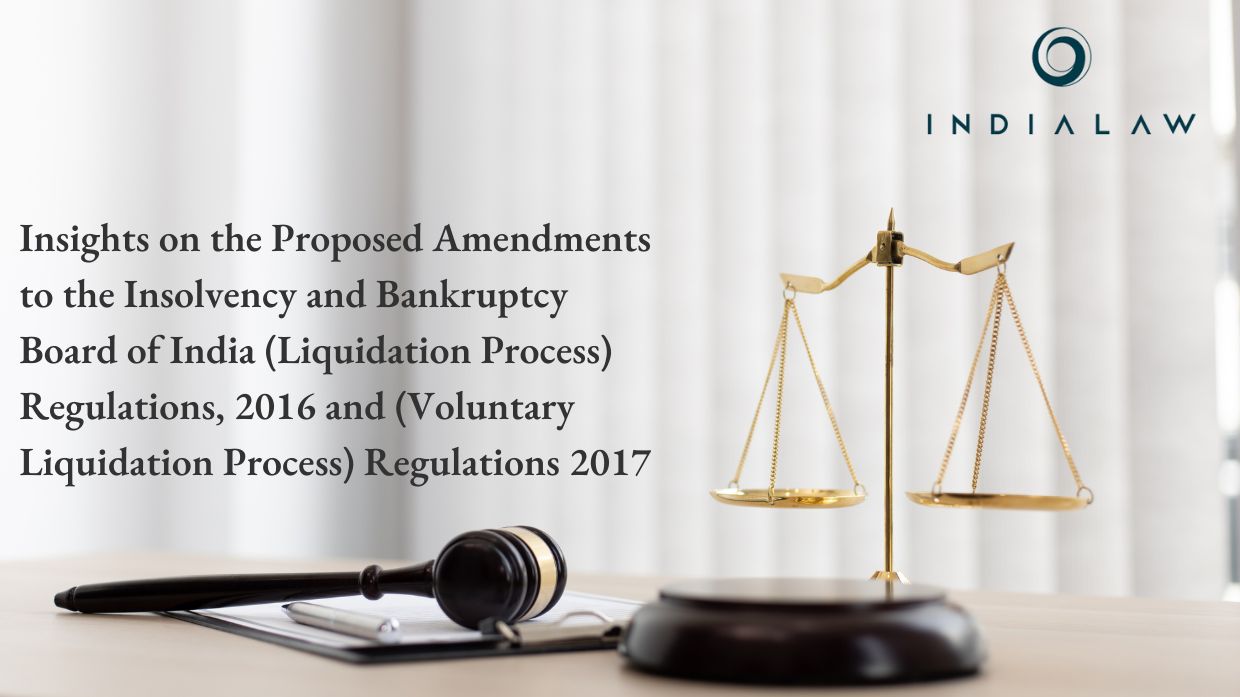Insights on the Proposed Amendments to the Insolvency and Bankruptcy Board of India (Liquidation Process) Regulations, 2016 and (Voluntary Liquidation Process) Regulations 2017

The Insolvency and Bankruptcy Board of India (IBBI) released a discussion paper on 19th November, 2024, seeking comments on proposed changes to the Insolvency and Bankruptcy Board of India (Liquidation Process) Regulations, 2016 and (Voluntary Liquidation Process) Regulation, 2017. The Insolvency and Bankruptcy Board of India (IBBI) has recommended several changes in the liquidation process under the Insolvency and Bankruptcy Code (IBC), in order to enhance overall efficiency, increase stakeholder confidence, and improve financial outcome for all parties involved. We have summarized our views and recommendations on the proposed amendments as follows:
Table of Contents
Part A: Liquidation Regulation
Proposal 1: Review of Auction Framework
The proposal allows prospective bidders in an auction to participate based on an affidavit/declaration of eligibility under Section 29A. If a bidder submits a false affidavit, their Earnest Money Deposit (EMD) will be forfeited, deterring ineligible participants and ensuring serious bids. This measure is expected to minimize misuse, as bidders will carefully provide accurate information, and the liquidator will consult the Stakeholders Consultation Committee (SCC) before forfeiting the EMD. Additionally, the liquidator must consult the SCC before rejecting the highest bid above the reserve price.
Our View:
- Eligibility Verification under Section 29A
The proposal to require prospective bidders to confirm their eligibility under Section 29A of the Insolvency and Bankruptcy Code (IBC), 2016 is a positive step toward ensuring that only eligible bidders participate in the auction process.
During the bidding process, bidders are required to submit a variety of documents to demonstrate their eligibility, including details about their financial standing, antecedents, compliance with regulatory requirements. This can often be a time-consuming and resource-intensive process. By permitting bidders to submit just an undertaking initially, the entry barrier for participation in the bidding process is lowered. This means that bidders would only need to commit to complying with the requirements at a later stage, reducing initial delays.
A simplified entry mechanism could encourage more potential bidders to participate in the process, particularly smaller or less resourceful entities who may hesitate to engage due to the administrative burden of compliance documentation. The potential for more bidders to participate may result in a more competitive auction, which can drive better outcomes for the creditors in terms of higher bids.
By introducing a prescribed format, IBBI can aim to bring uniformity to the process. This would eliminate inconsistencies and ensure that all bidders submit the necessary information in a structured and predictable manner. The liquidator’s role involves conducting due diligence on potential bidders to assess their credibility, financial soundness. If bidders submit documents in a prescribed format, it becomes much easier for the liquidator to process and evaluate the information in a systematic way. A prescribed format would reduce the chances of incomplete, missing, or incorrect documents, helping to streamline the entire process. With a standardized format, both bidders and Liquidator will save time and resources. Bidders will be able to quickly gather and submit the required documents without confusion, while Liquidator will be able to perform their due diligence more efficiently and effectively.
Preventing delays and enhancing transparency by confirming bidder eligibility upfront will ensure smoother operations and reduce the risk of forfeiture of Earnest Money Deposit (EMD) during the auction.
- Confidentiality of Bidders
Ensuring confidentiality of the bidders during the auction is crucial for protecting their strategic interests. However, the process for depositing the EMD and maintaining confidentiality needs to be clearly outlined. The circular issued by the IBBI should also clearly define what information is to be kept confidential and outline measures to prevent accidental disclosure. Clarity and consistency will help ensure fair and transparent processes, particularly in sensitive sectors where bidders may have concerns over disclosing their participation.
- Due Diligence and Verification of H1 Bidder
The proposal to conduct due diligence within three days after the declaration of the highest bidder is positive. However, this timeline may be too short in some cases, especially if complex corporate structures are involved. Extend the due diligence period to seven days or provide flexibility based on the complexity of the verification process.
In the event that a bid is found to contain a defect, the bidder shall be given an opportunity to cure the defect, provided that the defect is curable. The defect must be curable, and the bidder must be able to rectify the issue within a reasonable timeframe. The bidder shall be notified in writing, specifying the nature of the defect and the required corrective action. The bidder shall be given a reasonable timeframe (e.g., 3-5 working days) to cure the defect. The bidder shall resubmit a revised bid, addressing the defect, within the stipulated timeframe.
By providing an opportunity to cure defects, the bidding process becomes more robust, and bidders are given a fair chance to rectify minor issues, ensuring the best value for the procurement.
- Consultation with the SCC
The requirement for mandatory consultation with the Stakeholders’ Consultation Committee (SCC) when the highest bid is deemed unacceptable above the reserve price is prudent. This ensures that stakeholders’ interests are protected.
Clarify the process by which the SCC’s opinion is sought and define the specific circumstances that warrant a rejection of the highest bid. Clear guidelines will prevent ambiguity and ensure that all parties understand when consultation is mandatory and how it influences decision-making.
The IBC’s ultimate goal is to facilitate the timely resolution of distressed assets, ensure maximum recovery for creditors, and preserve the value of the company. In cases where the liquidator rejects the H1 bidder, the SCC needs to ensure that the rejection aligns with core objectives, rather than just focusing on the procedural or technical aspects of the bid.
The SCC’s role should go beyond merely verifying that the liquidator followed due process; it must also assess the substance of the decision. If the H1 bid is rejected, the SCC must ensure that the rejection is justified by reasons such as the bidder’s non-compliance with eligibility criteria, their inability to perform auction, or any other valid reason that contributes to the overall resolution goal. The review process is not just about applying a rigid set of rules or rejecting decisions without due consideration. The SCC must apply its judgment with the highest level of wisdom, taking into account the spirit of the IBC, which is to maximize value for creditors and promote the revival of distressed companies. A code of conduct will help ensure that the SCC’s actions are transparent and accountable. It can provide a framework within which committee members must operate, making sure that their decisions are not arbitrary or influenced by external pressures, but are based on sound reasoning and aligned with the objectives of the IBC.
In conclusion, the IBBI’s proposal to involve the SCC in reviewing the liquidator’s decision to reject the H1 bidder, along with the introduction of a code of conduct, is designed to ensure that the review process is not just technical, but wise, reasoned, and in line with the ultimate goals of the IBC, achieving timely and maximum recovery, and preserving the value of distressed assets for all stakeholders involved.
Proposal 2: Compromise or Arrangement (Regulation 45 Amendment)
The proposal mandates liquidators to file the final report with Form H when submitting an application for approval of a scheme under Section 230 of the Companies Act, 2013. This aims to enhance oversight, transparency, and accountability in the liquidation process, strengthening the regulatory framework and ensuring stakeholders are well-informed.
Our View:
The proposal to require the liquidator to file a final report along with Form H when an application for approval of a scheme of compromise or arrangement is filed under Section 230 of the Companies Act, 2013 is an important step toward enhancing transparency and efficiency. Establishing a deadline will improve predictability in the liquidation process and reduce the likelihood of undue delays.
Proposal 3: Corporate Liquidation Account (Regulation 46 Amendment)
The proposal suggests allowing the IBBI to permanently operate and manage the Corporate Liquidation Account, eliminating the need to maintain it within the Public Accounts of India (PAI). This change aims to streamline processes, expedite claim processing, and enhance fund management. Additionally, the IBBI may use interest income from the account to raise stakeholder awareness about unclaimed proceeds and the claiming process.
Our View:
The proposal to allow the IBBI to operate and manage the Corporate Liquidation Account (CLA) directly is a positive development. It is expected to lead to quicker decision-making and improved fund management. However, the amendment should ensure that the IBBI’s role in managing the Corporate Liquidation Account is subject to appropriate oversight and accountability. The retention of unclaimed proceeds in the Corporate Liquidation Account without their subsequent transfer to the Consolidated Fund of India may trigger government intervention due to its impact on public revenue generation. Under the current legal framework, unclaimed amounts from liquidation are required to be transferred to the Consolidated Fund of India after a certain period. By not adhering to this process, there could be implications for the government’s ability to utilize such funds for public purposes, including financing government expenditures and development projects. This situation might lead to calls for stricter regulation or intervention by the government to ensure that such funds are appropriately transferred, contributing to the consolidated revenue.
It is, therefore, recommended that the amendment should clearly define the procedures for handling unclaimed proceeds within the Corporate Liquidation Account, with a well-established timeline and criteria for transferring residual funds to the Consolidated Fund of India. This would ensure that the Corporate Liquidation Account remains aligned with the broader objectives of fiscal responsibility and transparency.
Part B: Voluntary Liquidation Regulation
Proposal 4: Corporate Voluntary Liquidation Account (Regulation 39 Amendment)
The proposal recommends allowing the IBBI to permanently operate and manage the Corporate Voluntary Liquidation Account, removing the need to maintain it within the Public Accounts of India (PAI). This change aims to streamline processes, expedite claim handling, and enhance fund management. Additionally, the IBBI may utilize interest income to educate stakeholders about unclaimed proceeds and the claiming process.
Our View:
Similar to the proposal for the Corporate Liquidation Account, the amendment to allow IBBI to manage the Corporate Voluntary Liquidation Account (CVLA) directly is a good step towards improving the efficiency of fund management in voluntary liquidation cases. Include provisions that outline the responsibilities of IBBI regarding the management of the CVLA, as well as safeguards to ensure that funds are properly managed. Clear accountability measures are essential to ensure that the IBBI’s management of the CVLA is effective and transparent.
Further, with regards to voluntary liquidation case, it is observed that in absence of proper guidelines and awareness amongst the stakeholders, concerned departments and Adjudicating Authorities, the process is often thwart midway resulting in exorbitant delay which ultimately defeats the very purpose of the enactment.
A company in voluntary liquidation may have various outstanding liabilities, including unpaid loans, taxes, salaries, or dues to suppliers. Identifying and settling these debts can be complicated, especially when creditors are not cooperative or when the liabilities are not fully document. Failure to accurately settle these liabilities can result in legal action against the liquidator or company, potentially prolonging the liquidation process. Such disputes can delay the liquidation process, lead to legal challenges, and increase administrative costs.
Tax liabilities, including unpaid taxes or the settlement of pending tax disputes, can complicate the liquidation process. The liquidator must ensure that all tax obligations are settled, which can be especially challenging if the company has outstanding tax assessments or audits. Unsettled tax liabilities can result in penalties, legal challenges, and even the annulment of the liquidation process.
Voluntary liquidation can sometimes take longer than expected, particularly if the company has complex operations, a large number of creditors, or assets that are difficult to liquidate. This can result in ongoing administrative costs and delays in the final distribution to creditors and shareholders. Prolonged liquidation processes can erode the value of the company’s assets and reduce the final payouts to creditors and shareholders.
Conclusion
The proposed amendments to the Insolvency and Bankruptcy Board of India (Liquidation Process) Regulations, 2016, and (Voluntary Liquidation Process) Regulations, 2017, aim to enhance efficiency, transparency, and accountability in the liquidation process. The suggestions provided above aim to ensure that these objectives are met while balancing the interests of all stakeholders involved in the process. While the proposals generally aim to streamline processes and reduce delays, there should be a clear definition of timelines for each step in the process. Include specific timelines for each major action under the amended regulations, including the timeline for the filing of reports, the due diligence process, and the consultation with the SCC. Defining timelines will provide greater clarity to all stakeholders and help avoid delays, which are often a key concern in liquidation and voluntary liquidation processes.
By entering the email address you agree to our Privacy Policy.



